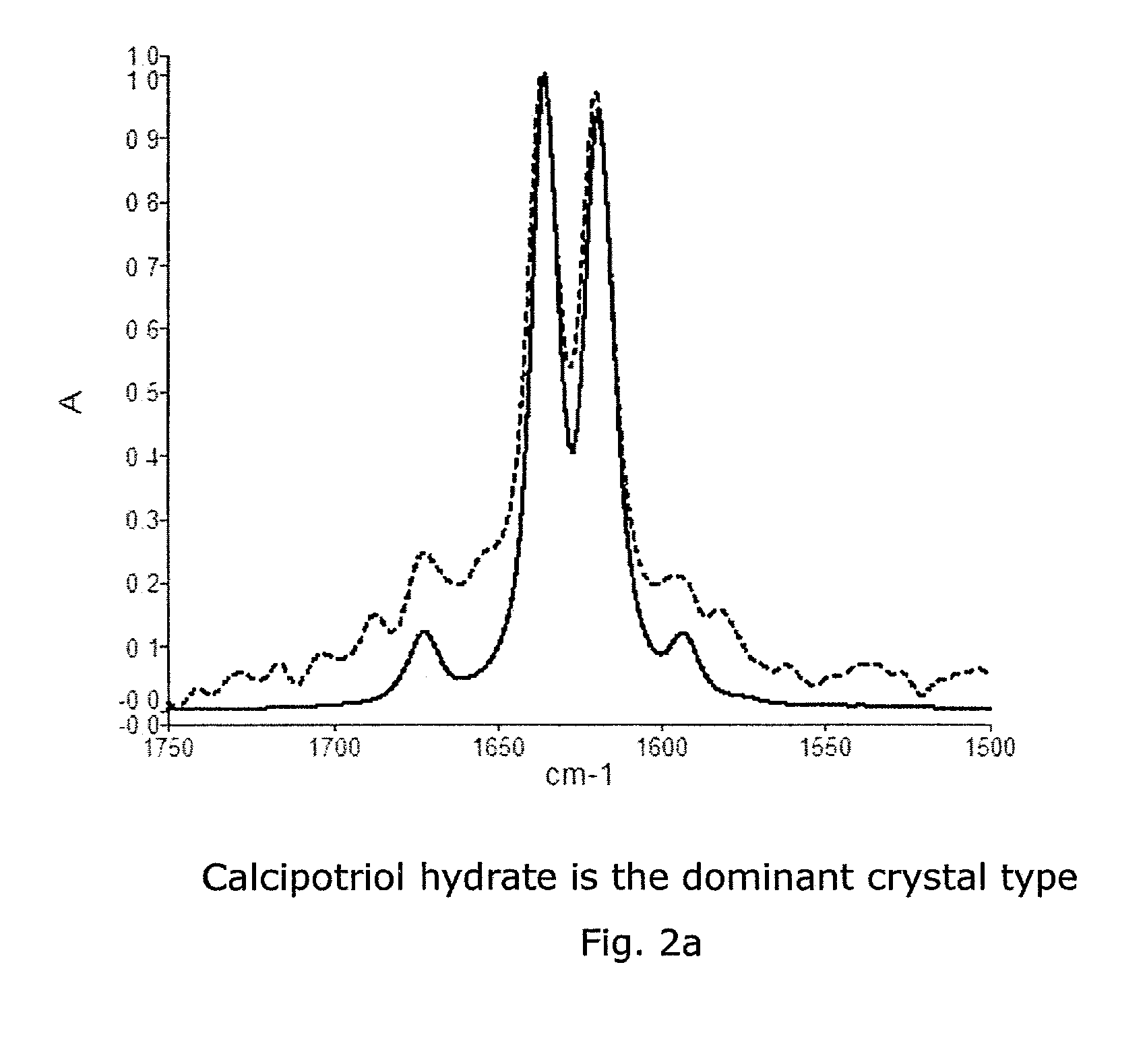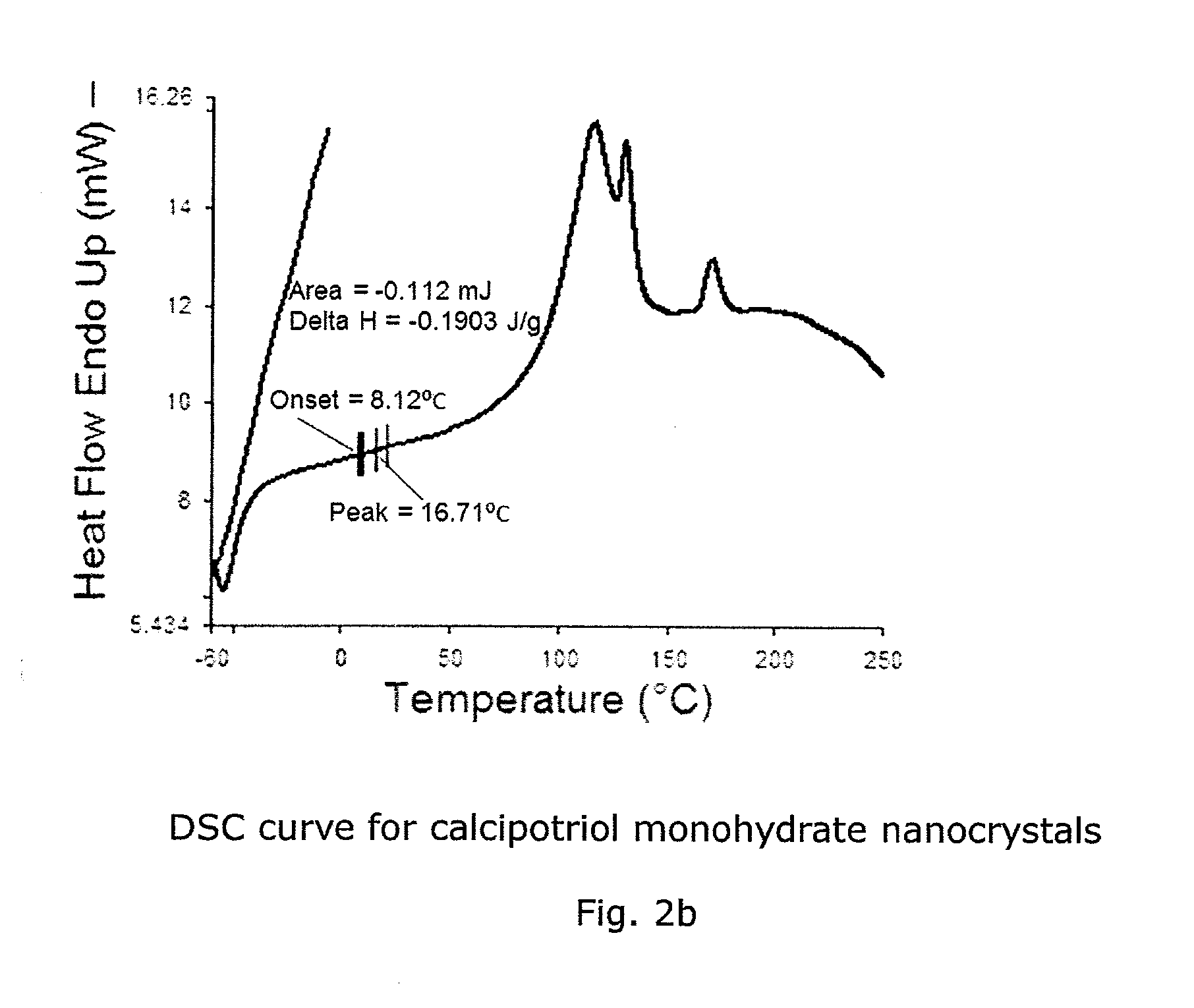Calcipotriol monohydrate nanocrystals
a nanocrystal and calcipotriol technology, applied in the direction of biocide, drug composition, aerosol delivery, etc., can solve the problems of not penetrated into the viable layers of the skin, complicated and significant skin irritation, so as to achieve a barrier against penetration and complicate the dermal administration of pharmaceuticals. , significant skin irritation
- Summary
- Abstract
- Description
- Claims
- Application Information
AI Technical Summary
Benefits of technology
Problems solved by technology
Method used
Image
Examples
example 1
Preparation of Calcipotriol Monohydrate Nanocrystals
[0071]4 g of poloxamer 188 was dissolved in 196 ml of laboratory water with stirring, and the pH was adjusted to 8.5 by adding an appropriate amount of NaOH.
[0072]3.5 g of 2 mm glass balls was weighed into two vials provided with a screw cap. 0.035 g of calcipotriol monohydrate was added to each vial, after which 1.05 g of the 2% poloxamer 188 solution was added to each vial. The calcipotriol monohydrate was milled by shaking on an orbital shaker (VXR Basic IKA Vibrax) at 2000 rpm.
[0073]After milling, the vials and glass balls used for milling were rinsed with 24.0 g of laboratory water, pH 8.5, and the calcipotriol monohydrate suspension was poured into a Blue Cap bottle. The suspension was transferred to an Emulsiflex C3 (Avestin) high pressure homogenizer, and the Blue Cap bottle was rinsed with 4.9 g of laboratory water, pH 8.5. High pressure homogenization was carried out at 500 bar for 10 minutes, at 1000 bar for 10 minutes a...
example 2
Ointments Containing Calcipotriol Monohydrate Nanocrystals
[0077]Ointments of the composition shown in Table 1 below were prepared by mixing the ingredients of the lipid phase (hydrocarbons+polyoxyethylene-2-stearyl ether+α-tocopherol) with heating to 80-85° C. and slow agitation. The aqueous phase was prepared by dissolving disodium edetate and disodium phosphate dihydrate in the appropriate amount of aqueous calcipotriol monohydrate nanosuspension (prepared as described in Example 1) adjusted to contain 50 μg / g calcipotriol monohydrate. Glycerol was added to the suspension with mixing and heating to 35-40° C. and the pH of the mixture was adjusted to 8.5 with 1N HCl or NaOH, as appropriate.
[0078]The aqueous phase was added to the lipid phase with whisking for 30 min. after which the resulting ointment was cooled slowly to below 32° C. and filled into aluminium tubes and stored at room temperature.
TABLE 1Ingredient (mg / g)Comp. AComp. BComp. CComp. DComp. EComp. FCalcipotriol monohyd...
example 3
Cream Containing Calcipotriol Monohydrate Nanocrystals
[0080]A cream of the composition indicated below in Table 2 was prepared by melting cetomacrogol 1000, cetostearylalcohol, liquid paraffin and white soft paraffin at 80° C. The aqueous phase was prepared by dissolving disodium phosphate dihydrate and chloroallylhexaminium chloride in purified water at 80° C. Glycerol was added to the solution with mixing, and the pH of the mixture was adjusted to 8.5 with 1N HCl or NaOH, as appropriate.
[0081]The aqueous phase was mixed with the lipid phase with homogenization and cooled to 55° C. The remaining water was added with vigorous stirring, and the resulting cream was cooled to 25° C. while stirring at slow speed.
[0082]An appropriate amount of the calcipotriol monohydrate nanosuspension (prepared as described in Example 1) adjusted to contain 50 μg / g calcipotriol monohydrate was added to the cream with mixing for 30 minutes at <30° C. The resulting cream was filled into tubes and stored ...
PUM
| Property | Measurement | Unit |
|---|---|---|
| particle size distribution | aaaaa | aaaaa |
| mean particle size | aaaaa | aaaaa |
| mean particle size | aaaaa | aaaaa |
Abstract
Description
Claims
Application Information
 Login to View More
Login to View More - R&D
- Intellectual Property
- Life Sciences
- Materials
- Tech Scout
- Unparalleled Data Quality
- Higher Quality Content
- 60% Fewer Hallucinations
Browse by: Latest US Patents, China's latest patents, Technical Efficacy Thesaurus, Application Domain, Technology Topic, Popular Technical Reports.
© 2025 PatSnap. All rights reserved.Legal|Privacy policy|Modern Slavery Act Transparency Statement|Sitemap|About US| Contact US: help@patsnap.com



